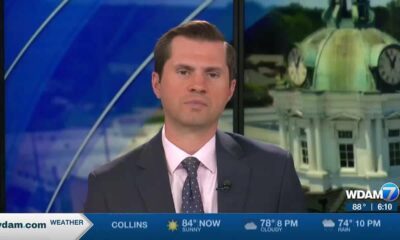Kaiser Health News
California Debates Extending PTSD Coverage to More First Responders
by Annie Sciacca
Tue, 09 May 2023 09:00:00 +0000
If you or someone you know may be experiencing a mental health crisis, contact the 988 Suicide & Crisis Lifeline by dialing “988,” or the Crisis Text Line by texting “HOME” to 741741.
A paramedic for about 30 years, Susan Farren knew all was not well with first responders: Eight of her colleagues had died by suicide. Others had grappled with substance abuse or gone through painful divorces.
So, in 2018, Farren founded a nonprofit in Santa Rosa to train and support emergency personnel struggling with trauma and stress. Hundreds of firefighters, police officers, and other first responders have since availed themselves of the organization's timely help.
“Nobody prepares you to walk into a house where four people have been murdered,” said Farren, executive director of First Responders Resiliency, Inc.
Firefighters, paramedics, and police often respond to the worst days of people's lives — accidents, deaths, fires, and other distressing events. After the deadly mass shootings earlier this year in Monterey Park and Half Moon Bay, and countless others across the country, awareness of how such trauma affects first responders has grown.
But there is no national consensus on when and which emergency personnel should be provided workers' compensation benefits.
“We wouldn't think twice about taking care of a first responder who broke their leg, and we shouldn't think twice about taking care of their mental health needs,” Karen Larsen, CEO of the Steinberg Institute, a nonprofit public policy institute, said in an email.
This year, there has been a push in California by first responders for laws that expand access to workers' compensation for post-traumatic stress injuries among their ranks. But some business groups and local governments want to pump the breaks, citing worries about potential fraud or abuse of the workers' compensation system.
The allegation that some people could take advantage of a more open workers' compensation system should not deter California from providing immediate access to mental health treatment to those who need it, said Farren, who noted that many of the first responders she works with are denied workers' compensation coverage or have to go through many steps to get it approved.
“That shouldn't keep us from getting help to those who really need it. That help should be available often, and affordably, and it should be available immediately,” Farren said.
Perceptions about employers' responsibility for alleviating work-related mental stress have changed over time, and that's showing up in workers' compensation. Each state has its own workers' compensation laws, which provide benefits like disability pay and medical care to workers injured or sickened on the job.
More than half have enacted PTSD policies or policy changes since 2018, according to a 2021 report by Optum, a company that creates workers' compensation programs. Coverage varies widely for post-traumatic stress injuries, which can be triggered by a single traumatic event or continued exposure to high stress and traumatic events.
In 2019, Gov. Gavin Newsom signed legislation into law to give California firefighters and police officers a stronger chance at earning workers' compensation. The bill, SB 542, authored by state Sen. Henry Stern (D-Calabasas) changed state law so that post-traumatic stress “injury,” such as PTSD, is legally presumed to be work-related for those first responders.
It was a small step by lawmakers in a state where recognition of work-related injuries for workers' compensation has typically been limited to physical illnesses such as heart disease and cancer. Previously, psychiatric conditions were handled differently, with employers and insurance companies long contending that psychological injuries can have many sources and might be too easy to blame on work.
Researchers at the Rand Corporation suggested in a 2021 report that further study is needed to evaluate the financial toll the 2019 law has had on employers — particularly counties and other municipalities that pay for police, firefighters, and other publicly employed first responders. Rand researchers estimated the added costs for local governments and the state to cover post-traumatic stress injuries could rise from $20 million to $116 million annually.
Firefighters and police in most cases now no longer have to prove that work was mostly responsible for their PTSD. But the law sunsets in 2025 and excludes many other first responders, including dispatchers, paramedics, and first responders at state hospitals.
This year, legislation by state Sen. John Laird (D-Santa Cruz), SB 623, co-sponsored by an advocacy group representing firefighters in the state — California Professional Firefighters — would extend PTSD workers' compensation coverage until 2032 and open it up to state firefighters, additional law enforcement officers, public safety dispatchers, and other emergency response communication employees who work for public agencies. The Senate Labor, Public Employment and Retirement Committee unanimously approved the bill in April, and it is awaiting a vote by the Senate Appropriations Committee.
Business groups and local governments — many of which opposed the 2019 law — are lobbying against more expansion. In letters to lawmakers, groups including the California Chamber of Commerce, California Coalition on Workers' Compensation, California Hospital Association, and California State Association of Counties warned that pending legislation could “open the door to abuse and fraud.”
“There is no evidence that workers are being inappropriately denied the care or benefits that they need,” Virginia Drake, a spokesperson for the California Coalition on Workers' Compensation, told KFF Health News. The group represents employers, cities and counties, insurance brokers, and government agencies on issues of workers' compensation.
Legislation that would extend benefits to more first responders would “put taxpayer funds at risk by tying the hands of public employers and forcing them to pay even the most questionable claims,” she added in a statement.
In addition, there does not seem to be consensus on which emergency personnel should get covered.
A measure by Assemblymember Freddie Rodriguez, a Democrat from Chino who worked as an emergency medical technician for three decades, has stalled. AB 597 would expand workers' compensation coverage to paramedics and emergency medical technicians, but it didn't get a hearing in the Assembly. Unions representing paramedics and EMTs in California did not return messages seeking comment.
“It's a very stressful job,” said Rodriguez, who told KFF Health News that two of his paramedic friends had died by suicide. “It affects people differently.”
Clearing a path to speedy mental health recovery, particularly after traumatic incidents, “should be automatic,” he added.
It's unclear if Newsom will back Laird's bill extending coverage for groups of emergency responders, amid a projected $22.5 billion deficit. A spokesperson for his office, Omar Rodriguez, said the governor typically does not comment on pending legislation and “will evaluate the bills on their own merits if they reach his desk.”
Last year, the Democratic governor vetoed similar legislation, saying in a statement that it would be premature to shift coverage of PTSD before any studies had been conducted on how the current law has worked for those who are covered.
Broadening coverage, Newsom wrote, “could set a dangerous precedent that has the potential to destabilize the workers' compensation system going forward.”
This article was produced by KFF Health News, which publishes California Healthline, an editorially independent service of the California Health Care Foundation.
KFF Health News is a national newsroom that produces in-depth journalism about health issues and is one of the core operating programs at KFF—an independent source of health policy research, polling, and journalism. Learn more about KFF.
USE OUR CONTENT
This story can be republished for free (details).
By: Annie Sciacca
Title: California Debates Extending PTSD Coverage to More First Responders
Sourced From: kffhealthnews.org/news/article/california-debates-extending-ptsd-coverage-first-responders/
Published Date: Tue, 09 May 2023 09:00:00 +0000
Did you miss our previous article…
https://www.biloxinewsevents.com/on-the-night-shift-with-a-sexual-assault-nurse-examiner/
Kaiser Health News
Watch: John Oliver Dishes on KFF Health News’ Opioid Settlements Series
Fri, 17 May 2024 09:00:00 +0000
Opioid manufacturers, distributors, and retailers are paying tens of billions of dollars in restitution to settle lawsuits related to their role in the nation's overdose epidemic. A recent broadcast of “Last Week Tonight With John Oliver” examined how that money is being spent by state and local governments across the United States.
The segment featured reporting from the KFF Health News series “Payback: Tracking the Opioid Settlement Cash.” You can learn more about the issue and read our collection of articles by Aneri Pattani here.
——————————
Title: Watch: John Oliver Dishes on KFF Health News' Opioid Settlements Series
Sourced From: kffhealthnews.org/news/article/watch-john-oliver-kff-health-news-payback-opioid-settlements-series/
Published Date: Fri, 17 May 2024 09:00:00 +0000
Kaiser Health News
KFF Health News’ ‘What the Health?’: Bird Flu Lands as the Next Public Health Challenge
Thu, 16 May 2024 18:30:00 +0000
The Host
Julie Rovner
KFF Health News
Julie Rovner is chief Washington correspondent and host of KFF Health News' weekly health policy news podcast, “What the Health?” A noted expert on health policy issues, Julie is the author of the critically praised reference book “Health Care Politics and Policy A to Z,” now in its third edition.
Public health officials are watching with concern since a strain of bird flu spread to dairy cows in at least nine states, and to at least one dairy worker. But in the wake of covid-19, many farmers are loath to let in health authorities for testing.
Meanwhile, another large health company — the Catholic hospital chain Ascension — has been targeted by a cyberattack, leading to serious problems at some facilities.
This week's panelists are Julie Rovner of KFF Health News, Rachel Cohrs Zhang of Stat, Alice Miranda Ollstein of Politico, and Sandhya Raman of CQ Roll Call.
Panelists
Rachel Cohrs Zhang
Stat News
Alice Miranda Ollstein
Politico
Sandhya Raman
CQ Roll Call
Among the takeaways from this week's episode:
- Stumbles in the early response to bird flu bear an uncomfortable resemblance to the early days of covid, including the troubles protecting workers who could be exposed to the disease. Notably, the Department of Agriculture benefited from millions in covid relief funds designed to strengthen disease surveillance.
- Congress is working to extend coverage of telehealth care; the question is, how to pay for it? Lawmakers appear to have settled on a two-year agreement, though more on the extension — including how much it will cost — remains unknown.
- Speaking of telehealth, a new report shows about 20% of medication abortions are supervised via telehealth care. State-level restrictions are forcing those in need of abortion care to turn to options farther from home.
- And new reporting on Medicaid illuminates the number of people falling through the cracks of the government health system for low-income and disabled Americans — including how insurance companies benefit from individuals' confusion over whether they have Medicaid coverage at all.
Also this week, Rovner interviews Atul Grover of the Association of American Medical Colleges about its recent analysis showing that graduating medical students are avoiding training in states with abortion bans and major restrictions.
Plus, for “extra credit,” the panelists suggest health policy stories they read this week that they think you should read, too:
Julie Rovner: NPR's “Why Writing by Hand Beats Typing for Thinking and Learning,” by Jonathan Lambert.
Alice Miranda Ollstein: Time's “‘I Don't Have Faith in Doctors Anymore.' Women Say They Were Pressured Into Long-Term Birth Control,” by Alana Semuels.
Rachel Cohrs Zhang: Stat's “After Decades Fighting Big Tobacco, Cliff Douglas Now Leads a Foundation Funded by His Former Adversaries,” by Nicholas Florko.
Sandhya Raman: The Baltimore Banner's “People With Severe Mental Illness Are Stuck in Jail. Montgomery County Is the Epicenter of the Problem,” by Ben Conarck.
Also mentioned on this week's podcast:
- Stat's “My Rendezvous With the Raw Milk Black Market: Quick, Easy, and Unchecked by the FDA,” by Nicholas Florko.
- The Stamford Advocate's “Dan Haar: Hackers Stole a Disabled CT Couple's SNAP Food Aid. Now They're Out $1,373,” by Dan Haar.
- WKRN's “‘Chaos': Nurses, Visitors Describe Conditions Inside Ascension Hospitals After Cyberattack,” by Stephanie Langston.
- KFF Health News' “Medicaid ‘Unwinding' Decried as Biased Against Disabled People,” by Daniel Chang.
- KFF Health News' “Why Medicaid's ‘Undercount' Problem Counts,” by Phil Galewitz.
Credits
Francis Ying
Audio producer
Emmarie Huetteman
Editor
To hear all our podcasts, click here.
And subscribe to KFF Health News' “What the Health?” on Spotify, Apple Podcasts, Pocket Casts, or wherever you listen to podcasts.
——————————
Title: KFF Health News' ‘What the Health?': Bird Flu Lands as the Next Public Health Challenge
Sourced From: kffhealthnews.org/news/podcast/what-the-health-347-bird-flu-next-public-health-challenge-may-16-2024/
Published Date: Thu, 16 May 2024 18:30:00 +0000
Kaiser Health News
California’s $12 Billion Medicaid Makeover Banks on Nonprofits’ Buy-In
Angela Hart
Thu, 16 May 2024 09:00:00 +0000
TURLOCK, Calif. — For much of his young life, Jorge Sanchez regularly gasped for air, at times coughing so violently that he'd almost throw up. His mother whisked him to the emergency room late at night and slept with him to make sure he didn't stop breathing.
“He's had these problems since he was born, and I couldn't figure out what was triggering his asthma,” Fabiola Sandoval said of her son, Jorge, now 4. “It's so hard when your child is hurting. I was willing to try anything.”
In January, community health workers visited Sandoval's home in Turlock, a city in California's Central Valley where dust from fruit and nut orchards billows through the air. They scoured Sandoval's home for hazards and explained that harsh cleaning products, air fresheners, and airborne dust and pesticides can trigger an asthma attack.
The team also provided Sandoval with air purifiers, a special vacuum cleaner that can suck dust out of the air, hypoallergenic mattress covers, and a humidity sensor — goods that retail for hundreds of dollars. Within a few months, Jorge was breathing easier and was able to run and play outside.
The in-home consultation and supplies were paid for by Medi-Cal, California's Medicaid health insurance program for low-income residents. Gov. Gavin Newsom is spearheading an ambitious $12 billion experiment to transform Medi-Cal into both a health insurer and a social services provider, one that relies not only on doctors and nurses, but also community health workers and nonprofit groups that offer dozens of services, including delivering healthy meals and helping homeless people pay for housing.
These groups are redefining health care in California as they compete with businesses for a share of the money, and become a new arm of the sprawling Medi-Cal bureaucracy that serves nearly 15 million low-income residents on an annual budget of $158 billion.
But worker shortages, negotiations with health insurance companies, and learning to navigate complex billing and technology systems have hamstrung the community groups' ability to deliver the new services: Now into the third year of the ambitious five-year experiment, only a small fraction of eligible patients have received benefits.
“This is still so new, and everyone is just overwhelmed at this point, so it's slow-going,” said Kevin Hamilton, a senior director at the Central California Asthma Collaborative.
The collaborative has served about 3,650 patients, including Sandoval, in eight counties since early 2022, he said. It has years of experience with Medi-Cal patients in the Central Valley and has received about $1.5 million of the new initiative's money.
By contrast, CalOptima Health, Orange County's primary Medi-Cal insurer, is new to offering asthma benefits and has signed up 58 patients so far.
“Asthma services are so difficult to get going” because the nonprofit infrastructure for these services is virtually nonexistent, said Kelly Bruno-Nelson, CalOptima's executive director for Medi-Cal. “We need more community-based organizations on board because they're the ones who can serve a population that nobody wants to deal with.”
Newsom, a Democrat in his second term, says his signature health care initiative, known as CalAIM, seeks to reduce the cost of caring for the state's sickest and most vulnerable patients, including homeless Californians, foster children, former inmates, and people battling addiction disorders.
In addition to in-home asthma remediation, CalAIM offers 13 broad categories of social services, plus a benefit connecting eligible patients with one-on-one care managers to help them obtain anything they need to get healthier, from grocery shopping to finding a job.
The 25 managed-care insurance companies participating in Medi-Cal can choose which services they offer, and contract with community groups to provide them. Insurers have hammered out about 4,300 large and small contracts with nonprofits and businesses.
So far, about 103,000 Medi-Cal patients have received CalAIM services and roughly 160,000 have been assigned personal care managers, according to state data, a sliver of the hundreds of thousands of patients who likely qualify.
“We're all new to health care, and a lot of this is such a foreign concept,” said Helena Lopez, executive director of A Greater Hope, a nonprofit organization providing social services in Riverside and San Bernardino counties, such as handing out baseball cleats to children to help them be active.
Tiffany Sickler runs Koinonia Family Services, which offers California foster children mental health and other types of care, and even helped a patient pay off parking tickets. But the program is struggling on a shoestring budget.
“If you want to do this, you have to learn all these new systems. It's been a huge learning curve, and very time-consuming and frustrating, especially without adequate funding,” she said.
Brandon Richards, a Newsom spokesperson, defended CalAIM, saying that it was “on the cutting edge of health care” and that the state was working to increase “awareness of these new services and support.”
For nonprofits and businesses, CalAIM is a money-making opportunity — one that top state health officials hope to make permanent. Health insurers, which receive hefty payments from the state to serve more people and offer new services, share a portion with service providers.
In some places, community groups are competing with national corporations for the new funding, such as Mom's Meals, an Iowa-based company that delivers prepared meals across the United States.
Mom's Meals has an advantage over neighborhood nonprofit groups because it has long served seniors on Medicare and was able to immediately start offering the CalAIM benefit of home-delivered meals for patients with chronic diseases. But even Mom's Meals isn't reaching everyone who qualifies, because doctors and patients don't always know it's an option, said Catherine Macpherson, the company's chief nutrition officer.
“Utilization is not as high as it should be yet,” she said. “But we were well positioned, because we already had departments to do billing and contracting with health care.”
Middleman companies also have their eye on the billions of CalAIM dollars and are popping up to assist small organizations to go up against established ones like Mom's Meals. For instance, the New York-based Nonprofit Finance Fund is advising homeless service providers how to get more contracts and expand benefits.
Full Circle Health Network, with 70 member organizations, is helping smaller nonprofit groups develop and deliver services primarily for families and foster children. Full Circle has signed a deal with Kaiser Permanente, allowing the health care giant to access its network of community groups.
“We're allowing organizations to launch these benefits much faster than they've been able to do and to reach more vulnerable people,” said Camille Schraeder, chief executive of Full Circle. “Many of these are grassroots organizations that have the trust and expertise on the ground, but they're new to health care.”
One of the biggest challenges community groups face is hiring workers, who are key to finding eligible patients and persuading them to participate.
Kathryn Phillips, a workforce expert at the California Health Care Foundation, said there isn't enough seed money for community groups to hire workers and pay for new technology platforms. “They bring the trust that is needed, the cultural competency, the diversity of languages,” she said. “But there needs to be more funding and reimbursement to build this workforce.”
Health insurers say they are trying to increase the workforce. For instance, L.A. Care Health Plan, the largest Medi-Cal insurer in California, has given $66 million to community organizations for hiring and other CalAIM needs, said Sameer Amin, the group's chief medical officer.
“They don't have the staffing to do all this stuff, so we're helping with that all while teaching them how to build up their health care infrastructure,” he said. “Everyone wants a win, but this isn't going to be successful overnight.”
In the Central Valley, Jorge Sanchez is one of the lucky early beneficiaries of CalAIM.
His mother credits the trust she established with community health workers, who spent many hours over multiple visits to teach her how to control her son's asthma.
“I used to love cleaning with bleach” but learned it can trigger breathing problems, Sandoval said.
Since she implemented the health workers' recommendations, Sandoval has been able to let Jorge sleep alone at night for the first time in four years.
“Having this program and all the things available is amazing,” said Sandoval, as she pointed to the dirty dust cup in her new vacuum cleaner. “Now my son doesn't have as many asthma attacks and he can run around and be a normal kid.”
This article was produced by KFF Health News, which publishes California Healthline, an editorially independent service of the California Health Care Foundation.
——————————
By: Angela Hart
Title: California's $12 Billion Medicaid Makeover Banks on Nonprofits' Buy-In
Sourced From: kffhealthnews.org/news/article/newsom-medicaid-12-billion-dollar-makeover-nonprofits-bureacracy-calaim/
Published Date: Thu, 16 May 2024 09:00:00 +0000
-
SuperTalk FM4 days ago
Martin Lawrence making 3 stops in Mississippi on comedy tour
-
Our Mississippi Home3 days ago
Beat the Heat with Mississippi’s Best Waterparks
-
Mississippi Today7 days ago
Lawmakers may have to return to Capitol May 14 to override Gov. Tate Reeves’ potential vetoes
-
Our Mississippi Home4 days ago
Charlie’s U-Pik: Opening Soon for the Summer Season
-
Mississippi News Video6 days ago
Local dentists offer free dental care in Amory
-
Kaiser Health News3 days ago
Medicaid ‘Unwinding’ Decried as Biased Against Disabled People
-
Mississippi News Video2 days ago
Jackson has a gang problem
-
Mississippi News7 days ago
Bond set for West Point couple accused of killing their child



























![HIGH SCHOOL SOFTBALL: Vancleave @ East Central (5/9/2024) [5A Playoffs, South State]](https://www.biloxinewsevents.com/wp-content/uploads/2024/05/1715460379_maxresdefault-80x80.jpg)








